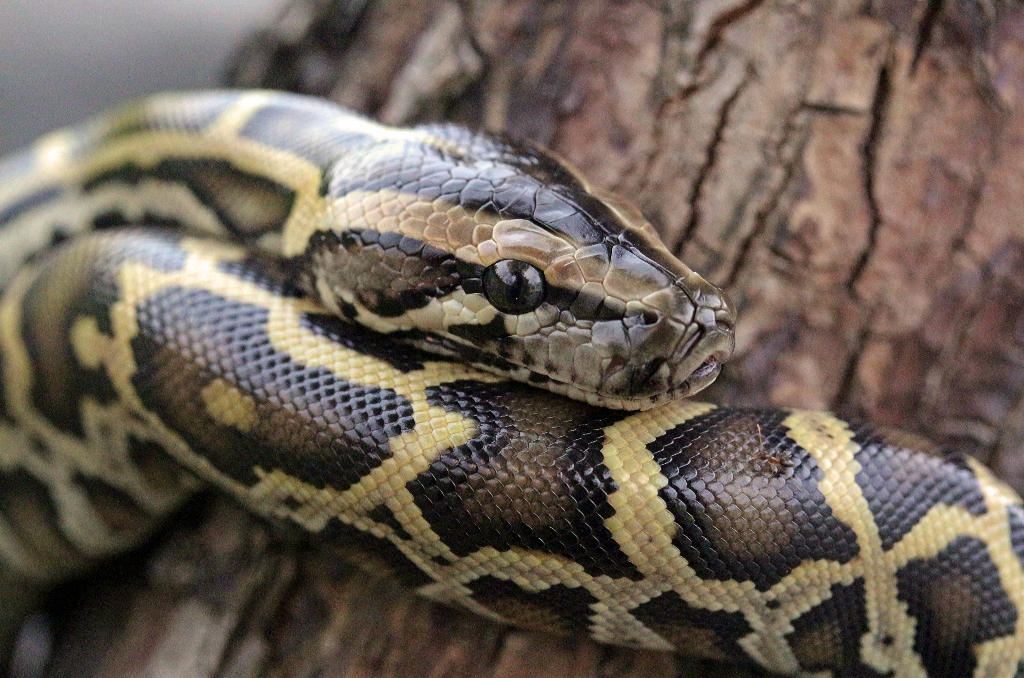Burmese Python. Photo: Vince Adam/Shutterstock.com
Imagine a predator invading your space that can grow up to 20 feet long or more and has a telephone-pole-sized girth. This intruder eats everything it can swallow, and indeed has been known to swallow animals twice its size. Small and medium-sized mammals are no match for this fiend that is wreaking havoc with the area’s ecosystem.
This invasive creature is what is known as a Burmese python, and it’s a predator that has been in the Florida Everglades for decades. It was first introduced to the area thanks in part to Hurricane Andrew in 1992. Twenty-six years ago Hurricane Andrew became the costliest storm in Florida’s history. Captive Burmese pythons were let loose by Andrew’s destruction and have flourished in the swampy environment of the South Florida ecosystem ever since .
Pet owners and exotic animal exhibitors in the U.S. also had a hand in this python epidemic. As natives of Southeast Asia, pythons were part of an exotic pet trade boom in the 1980s. The exotic animal exhibitors had started importing the Burmese python for their size and novelty in this part of the world. People who made these animals into pets found it difficult to care for something that grows to measure 15 to 20 feet in length, not to mention the expense it is to care for such a pet. Floridians found it easier to rid themselves of their pet by releasing it into the wild, which just so happens to also be the largest wilderness area in the eastern United States.
It is now illegal to import or purchase Burmese pythons in Florida. In 2010, the State made python pet ownership illegal.
At 734 square miles, Everglades National Park is almost two-thirds the size of Rhode Island and filled with an abundance of wildlife. The park is the most significant breeding ground for wading birds in North America, according to the National Park Service.
In 2012 a U.S. Geological Survey found that after Andrew hit the storm increased the Burmese python invasion. Raccoon and opossum populations decreased by 99 percent in the area and some species of rabbits and foxes became extinct. Only an alligator would become the pythons natural-born predator.
The government of Florida has tried to control the growing python population by hiring hunters and allowing open season on the snakes all year long. Florida residents are allowed to catch and kill Burmese pythons by any means necessary, with no permit required, especially on private lands. However, the python population has grown far faster than hunters can catch them. The snakes inhabit a vast area and reproduce rapidly. One female python can lay up to 100 eggs a year. A python’s lifespan can extend to 15 years. There are an estimated 100,000 Burmese pythons that currently inhabit the Florida Everglades.
The Everglades is a unique environment. One of the vastest subtropical wetlands on Earth. It is a flowing river of grass that flows from Lake Okeechobee across the southern quarter of the state. From north to south it covers more than one hundred miles. Porous limestone bedrock provides the Everglades its floor. The plants that grew and decayed over millennia have laid down layers of peat on top of that. The Everglades has sawgrass prairie, pine tree-covered ground, small limestone islands, cypress swamps, and mangrove forests along the ocean.
People are not too fond of snakes. Scientists who work with snakes don’t like it when someone says, “I hate snakes.” Don’t worry, though. The feeling is mutual: pythons (snakes) do not like us, either. A python’s typical reaction to a human being is to hide or try to get away. “Man is a creature of meaningful intentions.” That is true of pythons.

